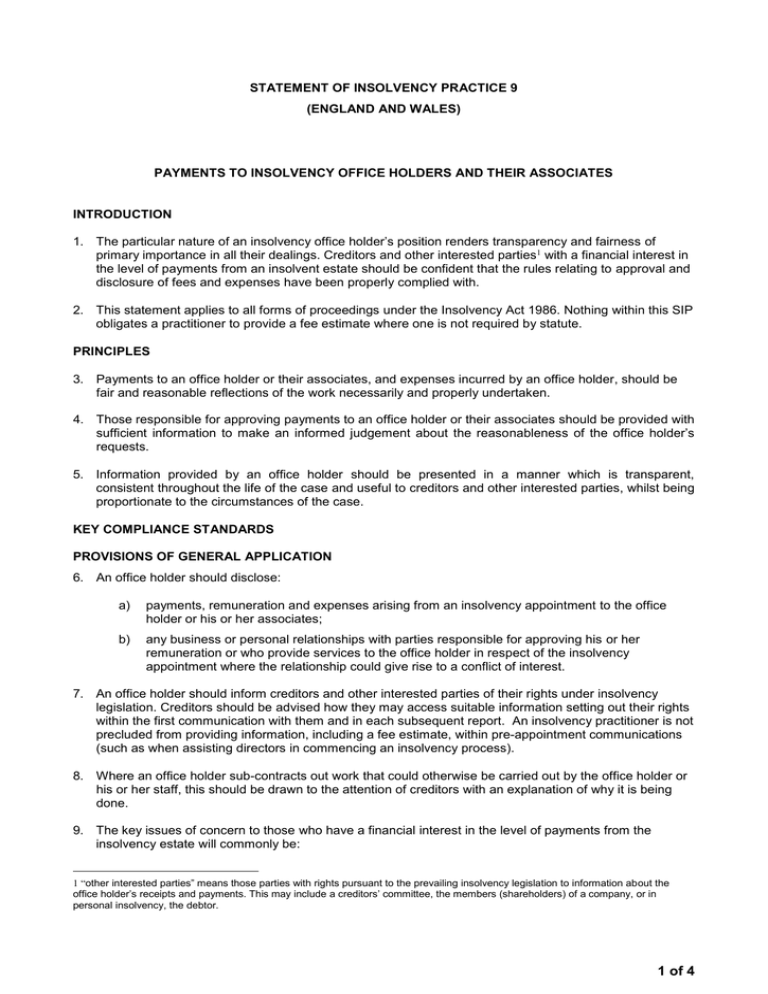SIP 9 (E W) - Payments to insolvency practitioners and their associates
advertisement

STATEMENT OF INSOLVENCY PRACTICE 9 (ENGLAND AND WALES) PAYMENTS TO INSOLVENCY OFFICE HOLDERS AND THEIR ASSOCIATES INTRODUCTION 1. The particular nature of an insolvency office holder’s position renders transparency and fairness of primary importance in all their dealings. Creditors and other interested parties1 with a financial interest in the level of payments from an insolvent estate should be confident that the rules relating to approval and disclosure of fees and expenses have been properly complied with. 2. This statement applies to all forms of proceedings under the Insolvency Act 1986. Nothing within this SIP obligates a practitioner to provide a fee estimate where one is not required by statute. PRINCIPLES 3. Payments to an office holder or their associates, and expenses incurred by an office holder, should be fair and reasonable reflections of the work necessarily and properly undertaken. 4. Those responsible for approving payments to an office holder or their associates should be provided with sufficient information to make an informed judgement about the reasonableness of the office holder’s requests. 5. Information provided by an office holder should be presented in a manner which is transparent, consistent throughout the life of the case and useful to creditors and other interested parties, whilst being proportionate to the circumstances of the case. KEY COMPLIANCE STANDARDS PROVISIONS OF GENERAL APPLICATION 6. An office holder should disclose: a) payments, remuneration and expenses arising from an insolvency appointment to the office holder or his or her associates; b) any business or personal relationships with parties responsible for approving his or her remuneration or who provide services to the office holder in respect of the insolvency appointment where the relationship could give rise to a conflict of interest. 7. An office holder should inform creditors and other interested parties of their rights under insolvency legislation. Creditors should be advised how they may access suitable information setting out their rights within the first communication with them and in each subsequent report. An insolvency practitioner is not precluded from providing information, including a fee estimate, within pre-appointment communications (such as when assisting directors in commencing an insolvency process). 8. Where an office holder sub-contracts out work that could otherwise be carried out by the office holder or his or her staff, this should be drawn to the attention of creditors with an explanation of why it is being done. 9. The key issues of concern to those who have a financial interest in the level of payments from the insolvency estate will commonly be: 1 “other interested parties” means those parties with rights pursuant to the prevailing insolvency legislation to information about the office holder’s receipts and payments. This may include a creditors’ committee, the members (shareholders) of a company, or in personal insolvency, the debtor. 1 of 4 a) the work the office holder anticipates will be done and why that work is necessary; b) the anticipated cost of that work, including any expenses expected to be incurred in connection with it; c) whether it is anticipated that the work will provide a financial benefit to creditors, and if so what anticipated benefit (or if the work provides no direct financial benefit, but is required by statute); d) the work actually done and why that work was necessary; e) the actual costs of the work, including any expenses incurred in connection with it, as against any estimate provided; f) whether the work has provided a financial benefit to creditors, and if so what benefit (or if the work provided no direct financial benefit, but was required by statute); When providing information about payments, fees and expenses to those with a financial interest in the level of payments from an insolvent estate, the office holder should do so in a way which facilitates clarity of understanding of these key issues. Narrative explanations should be provided to support any numerical information supplied. Such an approach allows creditors and other interested parties to better recognise the nature of an office holder’s role and the work they intend to undertake, or have undertaken, in accordance with the key issues. Where it is practical to do so, the office holder should provide an indication of the likely return to creditors when seeking approval for the basis of their remuneration. 10. When approval for a fixed amount or a percentage basis is sought, the office holder should explain why the basis requested is expected to produce a fair and reasonable reflection of the work that the office holder anticipates will be undertaken. 11. When providing a fee estimate the office holder should supply that information in sufficient time to facilitate that body making an informed judgement about the reasonableness of the office holder’s requests. Fee estimates should be based on all of the information available to the office holder at the time that the estimate is provided and may not be presented on the basis of alternative scenarios and/or provide a range of estimated charges. 12. Each part of an office holder’s activities will require different levels of expertise, and therefore related cost. It will generally assist the understanding of creditors and other interested parties to divide the office holder’s narrative explanations and any fee estimate provided into areas such as: a) Administration (including statutory reporting); b) Realisation of assets; c) Creditors (claims and distribution); d) Investigations; e) Trading (where applicable); f) Case specific matters (where applicable) These are examples of common activities and not an exhaustive list. Alternative or further sub-divisions may be appropriate, depending on the nature and complexity of the case and the bases of remuneration sought and/or approved. It is unlikely that the same divisions will be appropriate in all cases and an office holder should consider what divisions are likely to be appropriate and proportionate in the circumstances of each case. 2 of 4 13. When providing a fee estimate of time to be spent, creditors and other interested parties may find a blended rate2 (or rates) and total hours anticipated to be spent on each part of the anticipated work more easily understandable and comparable than detail covering each grade or person working on the case. The estimate should also clearly describe what activities are anticipated to be conducted in respect of the estimated fee. When subsequently reporting to creditors, the actual hours and average rate (or rates) of the costs charged for each part should be provided for comparison purposes. 14. Where remuneration is sought on more than one basis, it should be clearly stated to which part of the office holder’s activities the basis relates. In all cases, an office holder should endeavour to use consistent divisions throughout the duration of the case. The use of additional categories or further division may become necessary where a task was not foreseen at the commencement of the appointment. REPORTS TO CREDITORS AND OTHER INTERESTED PARTIES 15. Any disclosure by an office holder of payments, remuneration and expenses should be of assistance to those who have a financial interest in the level of payments from an insolvent estate in understanding what was done, why it was done, and how much it costs. 16. Irrespective of the basis or bases of remuneration approved, reports to creditors and interested parties should include a narrative update in respect of the office holder’s activity during the period being reported upon, using consistent divisions for each part of the work reported upon, as far as possible. 17. When reporting the amount of remuneration charged or expenses incurred during a period, the office holder should use a consistent format throughout the life of the case and provide figures for both the period being reported upon and on a cumulative basis. 18. Requests for additional information about payments to an office holder or their associates, or about expenses incurred by an office holder, should be treated by an office holder in a fair and reasonable way. The provision of additional information should be proportionate to the circumstances of the case. EXPENSES 19. Expenses are amounts properly payable by the office holder from the estate which are not otherwise categorised as the office holder’s remuneration or as a distribution to a creditor or creditors. These may include, but are not limited to, legal and agents’ fees, trading expenses and tax liabilities. When providing details of the expenses an office holder anticipates will, or are likely to be, incurred it is acceptable to provide a range, or repeat a range quoted by a third party (for instance for legal costs in litigation). DISBURSEMENTS 20. Disbursements are expenses met by and reimbursed to an office holder in connection with an insolvency appointment and will fall into two categories; Category 1 and Category 2. 21. Category 1 disbursements: These are payments to independent third parties where there is specific expenditure directly referable to the appointment in question. Category 1 disbursements can be drawn without prior approval, although an office holder should be prepared to disclose information about them in the same way as any other expenses. 22. Category 2 disbursements: These are expenses that are directly referable to the appointment in question but not to a payment to an independent third party. They may include shared or allocated costs that may be incurred by the office holder or their firm, and that can be allocated to the appointment on a proper and reasonable basis. Category 2 disbursements require approval in the same manner as an office holder’s remuneration. When seeking approval, an office holder should explain, for each category of cost, the basis on which the charge is being made. If an office holder has obtained approval for the basis of Category 2 disbursements, that basis may continue to be used in a sequential appointment where further approval of the basis of remuneration is not required, or where the office holder is replaced. 2 “A blended rate” is calculated as the prospective average cost per hour for the case (or category of work in the case), based upon the estimated time to be expended by each grade of staff at their specific charge out rate. 3 of 4 23. The following are not permissible as disbursements: a) a charge calculated as a percentage of remuneration; b) an administration fee or charge additional to an office holder’s remuneration; c) recovery of basic overhead costs such as office and equipment rental, depreciation and finance charges. PRE-APPOINTMENT COSTS 25. Where recovery of pre-appointment cost is expressly permitted and approval is sought for the payment of outstanding costs from the estate, disclosure should follow the principles and standards contained in this statement. Disclosure should also be made of amounts already paid to the office holder in respect of pre-appointment costs, giving the amounts paid, the name of the payor and its relationship to the estate and the nature of the payment. PAYMENTS TO ASSOCIATES 26. Where services are provided from within the practice or by a party with whom the practice, or an individual within the practice, has a business or personal relationship, an office holder should take particular care to ensure that the best value and service is being provided. An office holder should also have regard to relationships where the practice is held out to be part of a national or international network. 27. Payments that could reasonably be perceived as presenting a threat to the office holder’s objectivity by virtue of a professional or personal relationship should not be made unless disclosed and approved in the same manner as an office holder’s remuneration or category 2 disbursements. PROVISION OF INFORMATION TO SUCCESSIVE OFFICE HOLDERS 28. When an office holder’s appointment is followed by the appointment of another insolvency practitioner, whether or not in the same proceedings, the prior office holder should provide the successor with information in accordance with the principles and standards contained in this statement. PROVISION OF INFORMATION 29. In order to facilitate information requests under statute or to support the reporting of remuneration, time recording systems used by insolvency practitioners should record time units of not greater than 6 minutes for each grade of staff used. 30. Where realisations are sufficient for payment of creditors in full with interest, the creditors will not have the principal financial interest in the level of remuneration. An office holder should provide the beneficiaries of the anticipated surplus, on request, with information in accordance with the principles and standards contained in this statement. Effective Date: 01 December 2015 4 of 4





